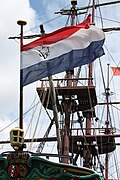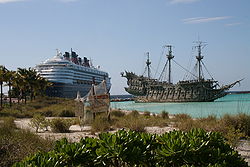The Flying Dutchman
Der fliegende Holländer (The Flying Dutchman) is an opera by Richard Wagner. Wagner wrote the libretto himself. The story comes from the legend of the Flying Dutchman, which is about the captain of a ship. It is his fate that he has keep sailing the sea, without ever going on to land, until Judgment Day.
| The Flying Dutchman | |
|---|---|
| by Richard Wagner | |
 Wagner, ca. 1840 | |
| Genre | Opera in 3 acts |
| Native title | Der fliegende Holländer |
| Librettist | Richard Wagner |
| Language | German |
| Based on | Legend |
| Premiere | Semper Oper, Dresden, Germany 1843 |
The most important idea in the story as told by Wagner is redemption through love. It was a favourite idea of Wagner, who used it a lot in his later operas.
Wagner conducted the first performance at the Semper Oper in Dresden, in 1843. It is an early opera of Wagner, but it shows his mature style. It is very different from the previous opera Rienzi which is still quite similar to operas that other composers were writing. In Der fliegende Holländer the drama is very important. Wagner uses a number of leitmotifs: musical ideas associated with particular characters and themes in the story. The leitmotifs are all introduced in the overture. We hear the famous leitmotif of the ocean and then those of the Dutchman and of Senta, the girl he falls in love with.
Wagner originally wrote Der fliegende Holländer to be performed without any breaks (intermission). Sometimes it is performed like that today, but Wagner also made a version with three acts.
The Flying Dutchman Media
View of Table Bay (overlooked by Kaapstad, Dutch Cape Colony) with ships of the Dutch East India Company, c. 1683.
An 18th-century painting of a VOC ship with Table Mountain in the background
Replica of an East Indiaman of the Dutch East India Company/United East Indies Company (VOC). The legend of the Flying Dutchman is likely to have originated from the 17th-century golden age of the VOC.
Book illustration showing superior mirages of two boats
Depiction of Richard Wagner's Opera Der fliegende Holländer
Disney's Flying Dutchman prop used in Pirates of the Caribbean moored at Castaway Cay cruise ship terminal






